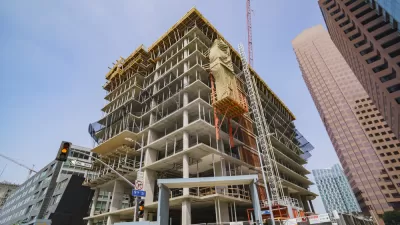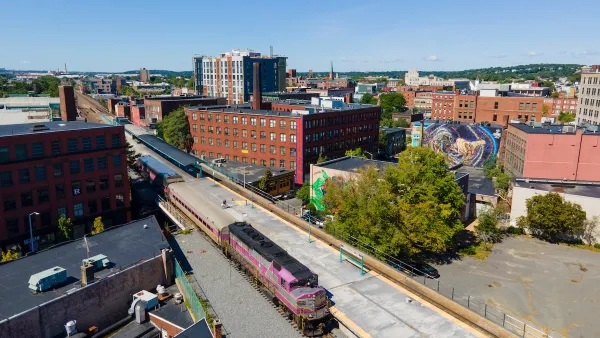Officials in Los Angeles were successful in implementing high-density growth policies to curb sprawl. However, a disconnect between culture, transportation policy, and the real estate market may have disastrous consequences.
Los Angeles real estate developers are pursuing high-density transit-oriented developments, similar to efforts in urban areas across the United States. However, the widespread availability of free parking, and lack of political momentum or support of public transportation, may cause these well-intentioned developments to create a city-wide traffic meltdown, instead of easing the region's long standing transportation woes.
"Six miles (10km) west of North Hollywood, a four-storey building is rising next to a car-wash on Ventura Boulevard. When finished, it will contain about 130 apartments and an underground car park. To an outsider it seems innocuous. To local residents, schooled by almost a century of strict zoning to believe that bedrooms must be separated from shops, it is anathema."
"Urban planners intone phrases like "transport-oriented development" and "elegant density". Yet nowhere has the dream of a house and a sun-drenched garden been so central to a city's identity for so long as in Los Angeles. So nowhere does the change come as such a shock."
"A big reason Angelenos drive everywhere is that they can park everywhere, generally free. Businesses must provide parking spaces according to a strict schedule. This raises the cost of doing business and hugely lowers the cost of driving."
FULL STORY: Tackling the hydra

Maui's Vacation Rental Debate Turns Ugly
Verbal attacks, misinformation campaigns and fistfights plague a high-stakes debate to convert thousands of vacation rentals into long-term housing.

Planetizen Federal Action Tracker
A weekly monitor of how Trump’s orders and actions are impacting planners and planning in America.

San Francisco Suspends Traffic Calming Amidst Record Deaths
Citing “a challenging fiscal landscape,” the city will cease the program on the heels of 42 traffic deaths, including 24 pedestrians.

Defunct Pittsburgh Power Plant to Become Residential Tower
A decommissioned steam heat plant will be redeveloped into almost 100 affordable housing units.

Trump Prompts Restructuring of Transportation Research Board in “Unprecedented Overreach”
The TRB has eliminated more than half of its committees including those focused on climate, equity, and cities.

Amtrak Rolls Out New Orleans to Alabama “Mardi Gras” Train
The new service will operate morning and evening departures between Mobile and New Orleans.
Urban Design for Planners 1: Software Tools
This six-course series explores essential urban design concepts using open source software and equips planners with the tools they need to participate fully in the urban design process.
Planning for Universal Design
Learn the tools for implementing Universal Design in planning regulations.
Heyer Gruel & Associates PA
JM Goldson LLC
Custer County Colorado
City of Camden Redevelopment Agency
City of Astoria
Transportation Research & Education Center (TREC) at Portland State University
Jefferson Parish Government
Camden Redevelopment Agency
City of Claremont





























